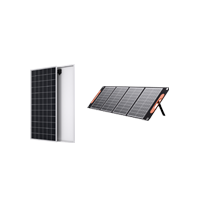Products Related
8 Going Solar Mistakes When Buying Your Home Solar System
Table of Contents
- Introduction
- Insufficient Research: The Pricey Cost of Ignorance
- Choosing the Wrong System Type: Grid-Tied, Hybrid, or Off-Grid?
- Misjudging Power Usage: A Critical Oversight
- Falling for Bad Deals: Beware of Power Purchase Agreements
- Misunderstanding Net Metering: A Tricky Terrain
- Falling for Marketing Gimmicks: No, the Free TV Isn’t Worth It
- Misunderstanding the Federal Tax Credit: It’s Not a Tax Rebate
- Neglecting Roof Condition: A Costly Afterthought
- Conclusion
- Frequently Asked Questions (FAQs)
Introduction
Embracing solar energy is an exciting journey, one that promises greener energy and potential savings on your electricity bill. However, it’s not a path devoid of pitfalls. When you’re just starting on this solar adventure, it’s all too easy to make some common “Going Solar Mistakes“. This can lead to frustration, unexpected expenses, and even disillusionment with solar power as a whole.
Insufficient Research: The Pricey Cost of Ignorance
One of the first and costliest mistakes homeowners make is not researching their equipment thoroughly enough. There’s a multitude of options out there, and diving deep into these choices is crucial if you want to maximize your investment. Here’s an example. There was a case in California where a homeowner installed solar panels from a relatively unknown company due to an attractive price point. Unfortunately, when the panels failed a few months later, the company had vanished, leaving the homeowner in the dark. So, remember, be an informed buyer, not just an excited one.
Choosing the Wrong System Type: Grid-Tied, Hybrid, or Off-Grid?
Another common mistake is picking the wrong system type for your specific needs. Grid-tied, hybrid, and off-grid systems each have their unique features, and understanding these is paramount to make the most of your solar installation. Take, for instance, the case of a Florida homeowner who opted for a grid-tied system, thinking it would provide power during hurricanes. They were later dismayed to learn that a grid-tied system goes offline when the main grid fails. Had they chosen a hybrid system with battery backup or an off-grid system, they wouldn’t have had to endure power outages.
Misjudging Power Usage: A Critical Oversight
It’s crucial to estimate your power usage accurately. Overestimating can lead to an unnecessarily expensive system, while underestimating can result in frequent power shortages. Get a clear understanding of your energy needs by studying your power bills or using an electricity monitoring system.
Falling for Bad Deals: Beware of Power Purchase Agreements
When going solar, you might come across what’s known as a Power Purchase Agreement (PPA). While it might sound like a great deal initially, PPAs are essentially long-term leases that can last up to 30 years, often with little to no savings. In most cases, you won’t even qualify for the federal tax credit since you won’t own the equipment.
Misunderstanding Net Metering: A Tricky Terrain
Net metering allows you to sell excess power back to the grid, but each power company has different rules. Some let credits expire at the end of the month or year, and if you don’t use them, they disappear. Make sure you understand your local power company’s net metering rules before diving in.
Falling for Marketing Gimmicks: No, the Free Stuff Isn’t Worth It
While a free gift card might look like a great incentive, they’re nothing compared to the cost of a solar system. Beware of such marketing gimmicks and focus on what’s truly important: a system that meets your needs.
Misunderstanding the Federal Tax Credit: It’s Not a Tax Rebate
The Federal Tax Credit, recently extended at 30% for the next decade, is a significant incentive. However, it’s crucial to understand that it’s a tax credit, not a rebate. It can reduce what you owe in taxes, but you won’t get money back.
Neglecting Roof Condition: A Costly Afterthought
Finally, remember to consider your roof’s condition. If your roof is nearing the end of its lifespan (around 10 years old or older), it’s not the best candidate for a solar installation. You’d ideally want to replace the roof before or in conjunction with installing your solar system.
Conclusion
Avoiding the trap of “Going Solar Mistakes” is key to a successful solar transition. Equipped with this guide, you’re now ready to dodge common pitfalls and get the most from solar energy.
Remember, being informed is the first step to a mistake-free solar experience. Still have questions? Reach out or comment below. Let’s make your solar journey a bright and beneficial one, together.
Frequently Asked Questions (FAQs)
1. What are the most common mistakes when buying a solar power system for home?
Insufficient research, choosing the wrong system type, misjudging power usage, falling for bad deals, misunderstanding net metering, falling for marketing gimmicks, misunderstanding the federal tax credit, and neglecting roof condition are some of the most common mistakes.
2. How important is it to research before buying solar equipment?
It’s crucial to thoroughly research the equipment before making a purchase. Not all solar panels and systems are created equal, and understanding the pros and cons of each can save you from potential issues down the line.
3. What is the Federal Solar Tax Credit?
The Federal Solar Tax Credit, also known as the Investment Tax Credit (ITC), allows you to deduct 30% of the cost of installing a solar energy system from your federal taxes.
4. Can I install solar panels on an old roof? If your roof is 10 years old or older, it’s recommended to replace it before installing solar panels to avoid
Solahope Apollo Solar Panels (10 years warranty): https://www.technest.world/product/apollo-solar-panel/
Solahope E Series Balcony Solar System(400W/600W/800W): https://www.technest.world/product/solar-system/
More to Read:
Why Solar Energy is Important for a Sustainable Future: https://www.technest.world/why-solar-energy-is-important-for-a-sustainable-future/
Can I Put Solar Panels on My Balcony: https://www.technest.world/can-i-put-solar-panels-on-my-balcony-exploring-the-feasibility/




